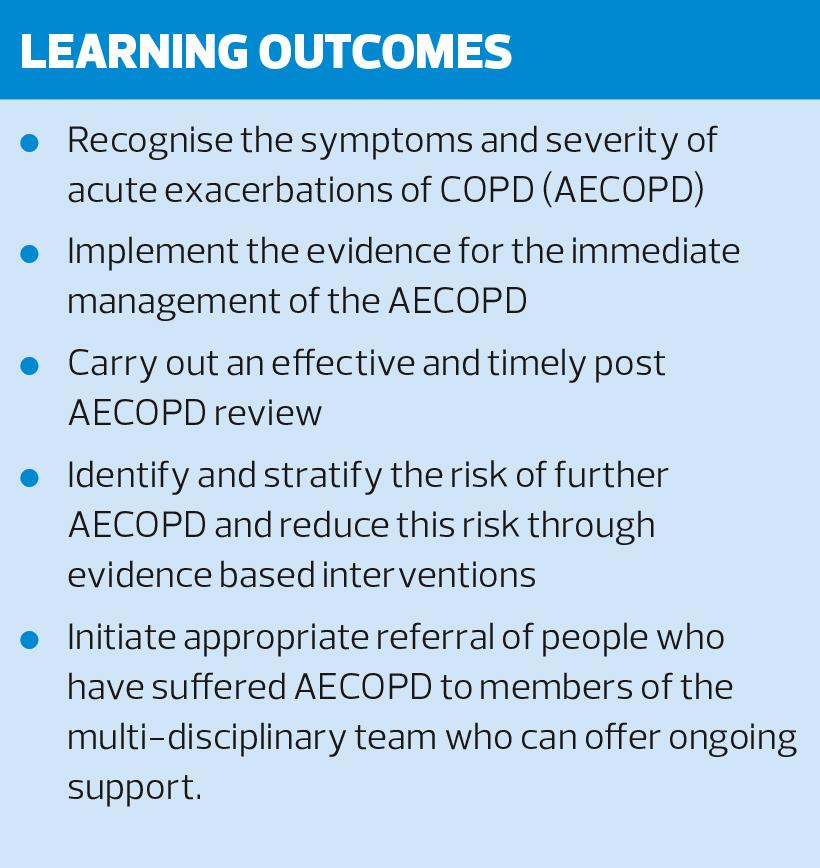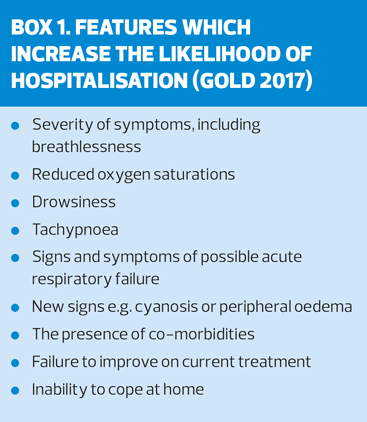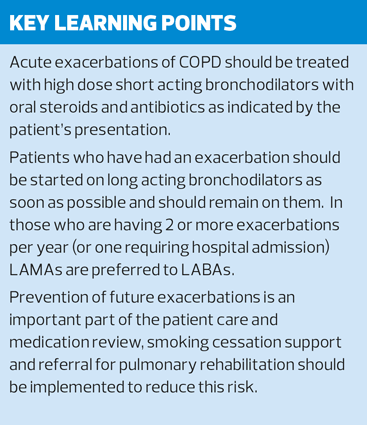
Management of acute exacerbations of COPD in primary care
Beverley Bostock-Cox
Beverley Bostock-Cox
RGN, MSc (Resp), MA (Med Ethics & Law) QN
Nurse Practitioner Mann Cottage Surgery Moreton in Marsh
Education Lead Education for Health Warwick
Last month we discussed the importance of preventing acute exacerbations of chronic obstructive pulmonary disease (AECOPD). This time, we consider the evidence based approach to recognising and managing any exacerbations that do occur
The GOLD guidelines on the diagnosis and management of COPD include advice on recognising and managing exacerbations.1 An exacerbation is an acute worsening of the classic symptoms of COPD – productive cough and breathlessness – which requires a change in medication, usually increasing bronchodilator use and introducing oral prednisolone and/or antibiotics.1 There are several causes of AECOPD, but the most common cause is a respiratory infection such as the cold or influenza virus or a bacterial infection such as haemophilus or pseudomonas.2 Other causes include pollution and temperature changes – the cold weather can increase exacerbation risk in winter but the heat in summer can have the same effect.3 The impact of an AECOPD is felt both in the short term and in the long term. The acute worsening of symptoms during an AECOPD needs to be addressed, but so does the subsequent higher risk of a further, permanent loss of lung function and a greater risk of dying after each exacerbation.4
RECOGNISING THE SYMPTOMS AND SEVERITY OF AECOPD
People with AECOPD may suffer from an increase in breathlessness, sputum production and/or sputum purulence, all of which may impact on quality of life and the ability to carry out the activities of daily living. GOLD categorises AECOPD as mild, moderate or severe:
- Mild exacerbations require extra short acting bronchodilators (SABDs) only
- Moderate exacerbations require SABDs plus oral steroids and/or antibiotics
- Severe exacerbations require attendance at and/or admission to hospital.
GOLD estimates that around one in five acute exacerbations will be severe and require admission. This therefore means that 80% of AECOPD can be managed in the community by patients themselves, with support from family, their carers and clinicians working in primary care as necessary.
THE IMMEDIATE MANAGEMENT OF EXACERBATIONS
The pharmacological management of an AECOPD will be based on the degree of breathlessness along with the amount and type of sputum being produced, compared with the patient’s normal level of symptoms.
In patients who are suffering from increased breathlessness, bronchodilators are the key to symptom relief so both short and long acting bronchodilators should be optimised. Regular short acting bronchodilators should be used to supplement long acting bronchodilators. Patients on long acting beta 2 agonists (LABAs) and/or long acting muscarinic antagonists (LAMAs) will benefit from additional short acting beta 2 agonists (SABAs). However, short acting muscarinic antagonists (SAMAs), should only be used in people who are not already on a LAMA. GOLD recommends that SABAs should be used at a rate of 1 puff per hour for the first 2-3 hours then every 2-3 hours, while continuing to use any long acting bronchodilators. Hand held devices such as pressurised metered dose inhalers (pMDIs) or dry powder inhalers (DPIs) will deliver the drugs just as effectively as a nebuliser (and more cost effectively). Nebulised therapy should be reserved for very ill patients who are unable to generate an adequate inspiratory flow rate for a pMDI or DPI, although this factor alone may suggest that the patient should be considered for admission.
The GOLD guidelines state that oral steroids can also be used to improve breathlessness, oxygen levels and lung function during an exacerbation.1 Although NICE recommends using 30mg of prednisolone for upwards of 7 days,6 the REDUCE study showed that a five day course of 40mg offered the greatest all round benefit (particularly in terms of recovery time and earlier discharge from hospital if admitted).7 GOLD advises that 40mg given for 7 days may be needed for some patients.1
Antibiotics, used appropriately, have the same sort of impact on the patient with AECOPD as oral steroids do – faster recovery, shorter in-patient stays and increased time between exacerbations. GOLD recommends using the Anthonisen criteria8 to identify those most likely to gain from antibiotic therapy. These criteria are: increased dyspnoea, increased sputum volume and increased sputum purulence. However, increased sputum purulence is such an important predictor of bacterial infection that antibiotics may be indicated if this and just one of the other symptoms is present.9 Sputum culture should not be necessary routinely. If samples are taken, it is important to try to get samples to the laboratory as soon as possible in order to identify any bacteria as delays may result in false negative results. Patients who are having recurrent episodes of AECOPD or who have failed to respond to standard treatment may benefit from sputum culture. Other methods of identifying the need for antibiotic therapy include near patient testing for C-reactive protein (CRP), which is included in the NICE guidelines on antibiotic prescribing for self-limiting respiratory tract infections.10 NICE has published Medtech Innovation Briefings (MIBs) on the equipment that can be used to carry out these tests.11,12
Stopping smoking is associated with a reduced risk of AECOPD and the longer the abstinence from smoking, the greater the benefit.13 The impact of AECOPD may increase an individual’s motivation to quit so the opportunity should be taken as soon as possible to discuss smoking cessation and offer support to quit. All primary care nurses should be able to offer smoking cessation advice and support and as discussed in the previous article free training can be accessed via the National Centre for Smoking Cessation and Training http://www.ncsct.co.uk/ .
THE POST AECOPD REVIEW
Early review following AECOPD is vital in order to ascertain how well the patient is recovering. It also allows a review of current and ongoing management, with the aim of reducing the risk of further exacerbations. GOLD states that the first follow up appointment should take place within a month of the exacerbation with a further follow up at three months. When reviewing someone post AECOPD, it is important to ask about any unreported exacerbations in order to manage future risk most effectively. This because many AECOPD are not reported by the patient but can still have a significant impact on health status. The GOLD guidelines recommend that the frequency, severity, type and potential cause of any AECOPD should be recorded along with specific information about sputum volume and purulence during an exacerbation, comparing this with the individual’s usual sputum. Any medication taken should also be recorded along with the response to treatment. The occasion of any AECOPD should prompt the clinician to review any existing COPD self-management plan including the provision of rescue packs of antibiotics and oral steroids. In those who have had two or more exacerbations in 12 months (or one severe exacerbation resulting in admission) the appropriate use of LAMAs, dual bronchodilators and ICS/LABAs should be reviewed with respect to their role in the prevention of further exacerbations.
PREVENTION OF FUTURE EXACERBATIONS
The Evaluation of COPD Longitudinally to Identify Predictive Surrogate End-Points (ECLIPSE) study revealed that patients who have a history of exacerbations are at greatest risk of future exacerbations.14 This effect was seen across all patients, regardless of their disease severity. People at highest risk of AECOPD will fall into category C and D of the GOLD (2017) ABCD algorithm as a result of having two or more exacerbations per year.
GOLD recommends that category C patients, who have a lower symptom burden but with a history of regular and/or severe exacerbations may benefit most from a LAMA as these have been shown to be helpful in reducing exacerbations.15 Using a dual bronchodilator may offer maximum symptom relief and exacerbation avoidance in patients in categories C and D. Category D patients are more symptomatic than category C but also have a history of recurrent and/or severe exacerbations. Currently GOLD states that dual bronchodilators are preferable to an ICS/LABA combination inhaler due to the risk:benefit ratio of dual bronchodilators versus inhaled steroids in COPD.16 Nonetheless, there is an evidence base for using ICS/LABAs to reduce exacerbations,17 so an ICS/LABA may be tried instead, especially if there is any history of asthma.
REFERRALS
Around 20% of all exacerbations of COPD are severe.1 Primary care clinicians should be alert to the need to admit people with severe exacerbations so that they can be managed appropriately to improve outcomes. GOLD suggests that the characteristics in Box 1 are associated with a more severe exacerbations which will require admission.
Being admitted to hospital is significant as this increases the risk of dying subsequently. According to Garcia-Aymerich et al5 the 5-year mortality rate following admission for AECOPD can be as high as 50%. Mortality rises in the elderly, those with a low BMI, those with comorbidities or a history of previous admissions and those needing long term oxygen therapy (LTOT).
Referral may also be made to other members of the multi-disciplinary team, including referral for pulmonary rehabilitation (PR) as people with a history of AECOPD may gain particular benefit from attending within 4 weeks following an admission to hospital for an exacerbation. In this high risk population, PR has been shown to reduce both readmission rates and mortality.18 AECOPD may also impact on the ability to carry out day to day tasks, such as housework or gardening, both in the short and the long term. This may mean that people may stop doing these tasks, which in turn increases the risk of deconditioning and which may affect mental as well as physical well-being.
CHOOSING INHALERS
Both drug and device are important when choosing inhalers for people with COPD and dexterity, potential side effects and cognitive function may all have an influence on the final decision. Short acting beta2 agonists such as salbutamol or terbutaline can be prescribed in pMDIs or DPIs. Ipratropium is a SAMA and is available as a pMDI. Long acting beta 2 agonists (LABAs) available as monotherapy include salmeterol, formoterol, indacaterol and olodaterol. LAMAs include tiotropium (Spiriva and Braltus), aclidinium (Eklira), glycopyrronium (Seebri) and umeclidinium (Incruse). Dual bronchodilators containing both a LAMA and a LABA are also available and can be used to optimise bronchodilation, reduce hyperinflation and reduce exacerbation risk.19,20 The FLAME study showed that indacaterol–glycopyrronium (Ultibro) was more effective than salmeterol-fluticasone in preventing COPD exacerbations in patients with a history of an exacerbation in the previous year. There was also a statistically significant difference in the rate of pneumonia in the group treated with the dual bronchodilator versus those who had the inhaled steroid based therapy.20
The four dual bronchodilators currently available on the market are Anoro (umeclidinium and vilanterol in the Ellipta device), Duaklir (aclidinium and formoterol in the Genuair device), Spiolto (tiotropium and olodaterol in the Respimat device) and Ultibro (glycopyrronium and indacaterol in the Breezhaler device).
GOLD 2017 prioritises the use of dual bronchodilators over an ICS/LABA in most people with a history of AECOPD, although the 2018 update is anticipated soon and it will be interesting to see if this view persists. In spite of the current approach endorsed by GOLD 2017, many people remain on an ICS/LABA for their COPD.
ICS/LABAs which are licensed for COPD include twice daily doses of Seretide 500mcg via the Accuhaler, Symbicort 400/12mcg via the Turbohaler or 200/6mcg 2 puffs bd via the pMDI device, Fostair 200/12mcg via the NextHaler or the pMDI, Duoresp 320/9mcg via the Spiromax device or Relvar 92/22mcg once daily via the Ellipta device. Again, decisions may be made on total daily dose of ICS, device preference or choice of the LABA as those which contain formoterol (Symbicort, Fostair, Duoresp) will have a faster onset of action than those containing other LABA molecules.
TRIPLE THERAPY FOR COPD
The GOLD guidelines suggest that some patients who have category D COPD will benefit from triple therapy: an ICS, LABA and LAMA. Earlier this year the first triple therapy in one inhaler device was launched. Trimbow® contains extra fine beclometasone with formoterol and glycopyrronium (i.e. Fostair with an additional LAMA) in a metered dose inhaler. The drug is licensed to use as maintenance therapy in people with moderate to severe COPD who are not adequately treated with an ICS/LABA combination and is taken as a set dose of 2 puffs twice daily. Key studies carried out using Trimbow include TRILOGY and TRINITY.21,22 The trials were carried out on people with moderate to severe COPD, defined by an FEV1 of less than 50% of predicted, a CAT test score of 10 or more and at least one exacerbation of COPD in the past year. TRILOGY compared Trimbow with Fostair alone while TRINITY compared Trimbow with tiotropium 18 micrograms daily used as monotherapy and also compared it with Fostair plus tiotropium. Compared with Fostair alone, Trimbow reduced the rate of moderate/severe exacerbations over 52 weeks by 23%. When compared with tiotropium, Trimbow reduced the rate of moderate/severe exacerbations over 52 weeks by 20% (rate: 0.46 versus 0.57 events per patient/year; p = 0.003). Compared with tiotropium, Trimbow also reduced the rate of severe exacerbations by 32%. Fostair plus tiotropium had the same effect on exacerbation rates as Trimbow. The time to the next exacerbation was significantly increased when triple therapy was used compared to using Fostair alone or tiotropium alone. These results suggest that using triple therapy in suitable patients has advantages over using an ICS/LABA or a LAMA alone. Trimbow is the first time triple therapy has been available in one device, meaning that with a regimen of 2 puffs twice daily, patients not only optimise symptom control but also reduce exacerbation risk. Other triple therapy inhalers are expected on the market soon.
CONCLUSION
AECOPD can have a significant effect on lung function, morbidity and mortality both in the acute phase and in the longer term. People who suffer more than two AECOPD per year are at increased risk of future exacerbations so it is important to manage the current episode and reduce future risk in order to optimise outcomes. Healthcare professionals should remember to ask patients about any history of AECOPD as many episodes go unreported. Patients too need to be aware of the symptoms of an acute exacerbation so that they can start treatment with bronchodilators and, where indicated, rescue packs of oral steroids and/or antibiotics. Following any exacerbation, healthcare professionals should use the GOLD ABCD algorithm to stratify the future risk of further AECOPD and implement appropriate interventions and referrals aimed at reducing any future risk.
REFERENCES
1. Global Initiative for Obstructive Lung Disease. Global strategy for the diagnosis, management and prevention of COPD, 2017. http://www.goldcopd.org
2. Sethi S, Murphy T. Infection in the pathogenesis and course of chronic obstructive pulmonary disease. N Engl J Med 2008;359:2355–65
3. Sapey E, Stockley R. COPD exacerbations.2: Aetiology. Thorax 2006;61:250–8
4. Schmidt SAJ, Johansen MB, Olsen M, et al. The impact of exacerbation frequency on mortality following acute exacerbations of COPD: a registry-based cohort study. BMJOpen 2014. http://bmjopen.bmj.com/content/4/12/e006720.full
5. Garcia-Aymerich J, et al. Lung function impairment, COPD hospitalisations and subsequent mortality Thorax 2011; 66:585-90.
6. NICE CG101. COPD diagnosis and management, 2010 https://www.nice.org.uk/guidance/cg101
7. Leuppi JD, et al. Short-term vs Conventional Glucocorticoid Therapy in Acute Exacerbations of Chronic Obstructive Pulmonary Disease: The REDUCE Randomized Clinical Trial. JAMA 2013;309(21):2223-31
8. Anthonisen NR, et al. Antibiotic therapy in exacerbations of chronic obstructive pulmonary disease Ann Intern Med 1987;106:196-204
9. Stockley RA et al. Relationship of sputum color to nature and outpatient management of acute exacerbations of COPD. Chest 2000;117(6):1638–1645
10. NICE. Self-limiting RTIs: antibiotic prescribing overview, 2017
11. NICE MIB78. QuikRead Go for CRP testing in primary care Medtech Innovation Briefing, 2016 https://www.nice.org.uk/advice/mib78
12. NICE MIB81. Alere Afinion CRP for CRP testing in primary care Medtech Innovation Briefing, 2016 https://www.nice.org.uk/advice/mib81
13. Au D, et al. The effects of smoking cessation on the risk of chronic obstructive pulmonary disease exacerbations. J Gen Intern Med 2009;24:457–463
14. Agusti A, et al. Characterisation of COPD heterogeneity in the ECLIPSE cohort. Respir Res 2010;11:122.
15. Halpin DG, et al. Effect of tiotropium on COPD exacerbations: A systematic review Respir Med 2016;114:1–8
16. Crim C, et al. Pneumonia risk in COPD patients receiving inhaled corticosteroids alone or in combination: TORCH study results. Eur Respir J 2009;34(3):641–647
17. Ernst P, Saad N, Suissa S. Inhaled corticosteroids in COPD. Eur Respir J 2015;45:525-537
18. Puhan MA, et al. Pulmonary rehabilitation following exacerbations of chronic obstructive pulmonary disease. Cochrane Database Syst Rev 2011;10: CD005305.
19. O’Donnell D, et al. Lung hyperinflation in COPD: applying physiology to clinical practice. COPD Research and Practice 2015;1:4
20. Wedzicha JA, et al. Indacaterol–Glycopyrronium versus Salmeterol–Fluticasone for COPD N Engl J Med 2016;374:2222-34
21. Singh D, et al (2016) Single inhaler triple therapy versus inhaled corticosteroid plus long-acting β2-agonist therapy for chronic obstructive pulmonary disease (TRILOGY): a double-blind, parallel group, randomised controlled trial The Lancet 2016;388(10048): 963–73
22. Vestbo J, et al (2017) Single inhaler extrafine triple therapy versus long-acting muscarinic antagonist therapy for chronic obstructive pulmonary disease (TRINITY): a double-blind, parallel group, randomised controlled trial. The Lancet 2017;389(10082):1919–29


